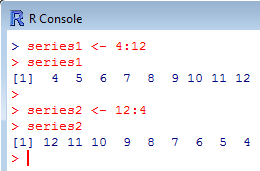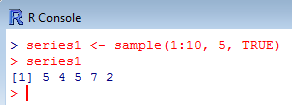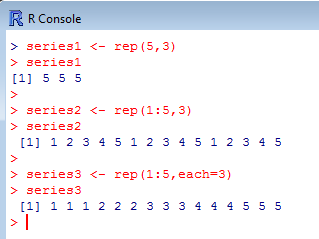Here you will find useful functions to create series of numbers to populate your tables and objects. These functions are also quite useful when you want to make a simulation or try functions on a random data set or on a test sample. Note that some functions return integers (numbers with no decimal) while other functions return numbers with (many) decimals.
X:Y is used to create a series of numbers ranging from X to Y:
[code language=”r”]
series1 <- 4:12
series1
series2 <- 12:4
series2[/code]

seq(from= X, to= Y, by= Z) is used to create a sequence of numbers ranging from X to Y by increments of Z:
[code language=”r”]
series1 <- seq(from= 2, to=18, by= 4)
series1
[/code]

runif(Y) returns a series of Y random numbers between 0 and 1:
[code language=”r”]
series1 <- runif(1)
series1
series2 <- runif(5)
series2
[/code]

runif(Y, min=X, max=Z) returns a series of Y random numbers ranging from X to Z:
[code language=”r”]
series1 <- runif(5, min=10, max=100)
series1
[/code]

floor(runif(Y, min=X, max=Z)) returns a series of Y random integers ranging from X to Z:
[code language=”r”]
series1 <- floor(runif(5, min=10, max=100))
series1
[/code]

NB: the function floor() rounds up the numbers by returning the largest integer not greater than the number to process.
sample(X, Y, replace=T/F) returns a sample of Y integers taken in the vector X. replace should be followed by either TRUE or FALSE. It defines whether or not the same data element can be chosen repeatedly in the sample.
[code language=”r”]
series1 <- sample(1:10, 5, TRUE)
series1
[/code]

An interesting property of the function sample() is that it can be used to shuffle a vector, something which can be useful for randomization of data elements. Simply omit the argument Y. In the following example, sample() has kept, shuffled and printed all values between 1 and 10:
[code language=”r”]
series2 <- 1:10
series2
sample(series2)
[/code]

rep(X, Y) repeats X as many times as defined by Y. Note that rep(X, each=Y) returns Y copies of the first item in X, then Y copies of the second item in X, then…
[code language=”r”]
series1 <- rep(5,3)
series1
series2 <- rep(1:5,3)
series2
series3 <- rep(1:5, each=3)
series3
[/code]

